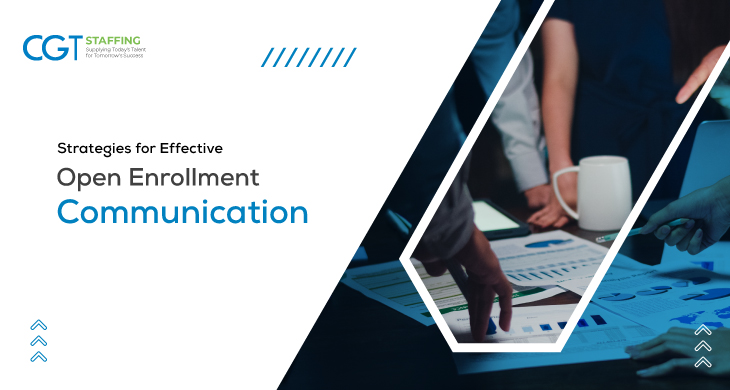Open Enrollment usually refers to a defined time period during which employees may enroll in a new benefits plan or make changes to their existing benefits plan. During this period, employees must select their benefits plan for the coming year, provided there are no events that qualify for additional changes during the course of the year.
Selecting a plan can be a stressful and complex decision for most workers; an effective communication plan can help streamline the enrollment process and encourage employees and management to take note. This blog explores the importance of Open Enrollment communication and three strategies to implement effective communication processes.
Table of Contents
 The Importance of Communication in Open Enrollment
The Importance of Communication in Open Enrollment
For employees and managers alike, enrolling in a benefits plan is very important. It can also be a complex and challenging process. These obstacles can impair participation and limit the number of people that are able to meet the enrollment deadline.
Frontline workers, or contractual employees without official email addresses, may find it even harder to enroll within the stipulated window. Some may not even receive the necessary information to participate in enrollment. The following challenges, in particular, are common across most Open Enrollment communication plans and programs:
- Complex and confusing subject material
- Improper understanding of the enrollment process
- Minimal or ineffective communication from employers
An effective open enrollment communication template is key to solving these challenges. It can help employees gain a clearer understanding of the process, make their choices more accessible, and increases overall participation. Here are three key strategies that can help build effective open-enrollment communication:
 Including Comprehensive Information in Emails
Including Comprehensive Information in Emails
This method is a great way to communicate the needs and requirements of an Open Enrollment to employers. The email should cover important information, including announcing the start of the enrollment program. It should clearly outline the key steps for employees to enroll, such as how to log into benefits software, how to access enrollment instructions, and how to confirm they have filled it out correctly.
An email communication model works best for this information. It can serve as a way to both announce the start of the enrollment period, as well as help employees, navigate the benefits software correctly, and educate them on choosing the right plan with all the necessary resources and instructions.
 Highlight the Importance of Meeting the Deadline
Highlight the Importance of Meeting the Deadline
To boost enrollment participation, employees must understand why it is important to adhere to the deadline. In other words, Open Enrollment communication must always have a component that highlights the impact of missing the deadline date.
The potential consequences can often act as a motivator for employees to enroll within the stated deadline window, but only if employees have a clear understanding of these consequences. They may not be as severe as some insubordination examples, but they should still be communicated effectively.
It is important that employers don’t use this as a scare tactic, but as an honest effort to communicate the realities of not enrolling on time. New employees that are enrolling for the first time, for example, may not receive any benefits for the year.
New dependents may not be added, or older ones may not be dropped. Benefits plan coverages may lapse unless renewed. These are all serious realities that, if made clear to employees, are more likely to boost enrollments within the time window.
 Focus on Employees Not Opening Enrollment Messages
Focus on Employees Not Opening Enrollment Messages
Putting extra effort into employees that are not opening or engaging with enrollment messages can help boost participation numbers. Many employees may feel intimidated by the enrollment process, find it to be too complex, or simply miss them during the course of their work. If employees aren’t opening the initial communications, there is a good chance that they won’t open the follow-up messages either.
Additional messaging built around these reasons for not opening the messages are more likely to encourage engagement and boost participation. Resources like frequently asked questions can be extremely effective for such employees, helping them clear out confusion and develop a clearer understanding of the entire process. It can help them to navigate the process, understand key milestones, and learn why it is important to stick to the stated deadline.
 Takeaway
Takeaway
Ensuring employee enrollment in benefits programs is crucial. It helps them make necessary changes to their benefits plans while giving employers enough room to incorporate these changes accurately. Just as in talent acquisition best practices, successful enrollment is contingent on two-way communication.
Ensuring employee participation and adherence to deadlines will always remain key milestones for the success of any enrollment program. The three strategies above may prove helpful to employers in achieving this success.
